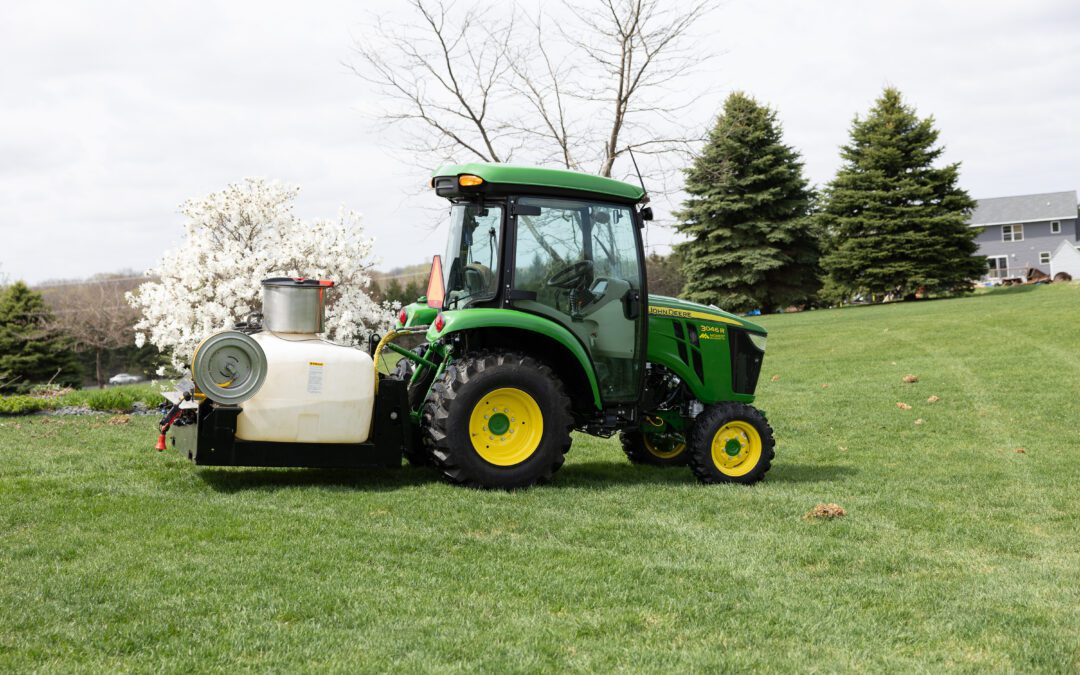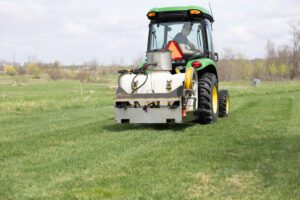The fastest way to spray a large yard for weeds depends on the specific circumstances and equipment available. However, here are some general steps and considerations to help you accomplish the task efficiently, including choosing the right weed sprayer.
Choose the Right Equipment
Select a sprayer that suits the size of your yard. For a large yard, a backpack sprayer, a tow-behind sprayer, or a 3-point sprayer, such as the LiquidRage, attached to a skid steer, tractor, or UTV may be suitable. When deciding which piece of equipment to use, the operator must consider their speed. On average, a tractor travels at 18 MPH, a skid steer travels at 10-12 MPH, and a UTV travels up to 85 MPH, which is not recommended.
Make sure the sprayer has adjustable nozzles for different spray patterns. This allows the operator to customize the sprayer to fit the needs of the turf they are spraying, making it as efficient as possible. Depending on the machine available, the operator may be limited to what sprayer is available to them. However, the LiquidRage attaches to all three without any modifications.
A tow-behind sprayer offers a max swath that ranges from 6-40ft. Most of them contain 10-60 gallons and emit 1-2.2 GPM (gallons per minute). There is also one that can emit up to 20 GPM. A tow-behind sprayer would be the most effective for emitting a lot of herbicide in short bursts.
A backpack sprayer contains up to 6.5 gallons and can cover about 1,000 sq ft with about 1.5 gallons. A backpack sprayer is a great option if the operator is doing patchwork in hard-to-reach places. However, it is not the tool if the operator is doing large pieces of land. Most backpack sprayers have 12-60 inches of swath and are distributed at ground speeds ranging from 1-5 MPH. They are also pressure adjustable from 40-150 PSI, depending on the application rate.
This requires bigger and better tools, such as the LiquidRage, a large, multipurpose weed sprayer tank. The LiquidRage broadcast nozzle kit emits 1 gallon per minute (GPM) at the recommended 40 PSI. The LiquidRage has a capacity of 150 gallons. If the operator is traveling at about 10MPH with a full tank at 40PSI, the operator will have to refill after about 2.5 hours of spraying a 30ft swath or roughly 45 acres without stopping to refill.
Liquid Rage Summer Kit
KAGE’s summer kit for its weed sprayer is equipped with everything you need to transform your LiquidRage into a broadleaf sprayer. Also, an ice control system, the LiquidRage becomes a professional weed sprayer for commercial and residential use.
It comes with a fan nozzle, two solenoid nozzles, and a wiring harness. The fan nozzle is easy to twist on and off onto the original sprayer bar. Each solenoid fan nozzle hooks up to the end of the bar and with the easy-install wiring harness. The operator can turn them on and off to adjust your swath from within the cab in seconds. The wiring harness is installed with a quick-connect plug that runs to the solenoids and a clamp up to the cab so the driver can place the switches where they are most convenient.
Hose Reel Kit
To maximize the use of the LiquidRage there is a hose reel kit that has an ergonomic mount to attach to the weed sprayer to what suits the operator best. With this, the operator can get into hard-to-reach places with the adjustable sprayer wand and thirty-foot hose. This is a great alternative to the backpack sprayer because the operator can utilize the LiquidRage to get into smaller areas without another tool to keep track of.
Click here to learn more about the LiquidRage.
Efficiency Notes
There are a few things to keep in mind when spraying for weeds such as, planning your approach, having a cleared area, and knowing your terrain to plan the best approach and to steer away from desirable plants.
Prepare the Weed Sprayer
Read and follow the manufacturer’s instructions to assemble and calibrate the sprayer properly by desired speed and swath width.
Plan Your Approach
Divide the yard into manageable sections and determine the most efficient spraying pattern for the lawn making note of where the desirable plants are. Consider starting from the farthest point and working your way back toward the exit to avoid stepping on freshly sprayed areas.
KAGE tested the LiquidRage on a 3-acre residential lot, and it took the operator about 10 minutes to complete using this method. To preserve desirable plants, consider the amount of space around them and decide if the equipment can fit maneuver around them. If not, consider using a plastic or cardboard shield to cover them our use the hose reel kit to spray that area. Before you begin spraying, make sure to clear you path to avoid any obstacles that may hinder the pray pattern or speed.




Recent Comments